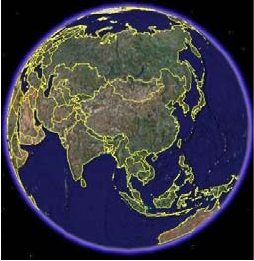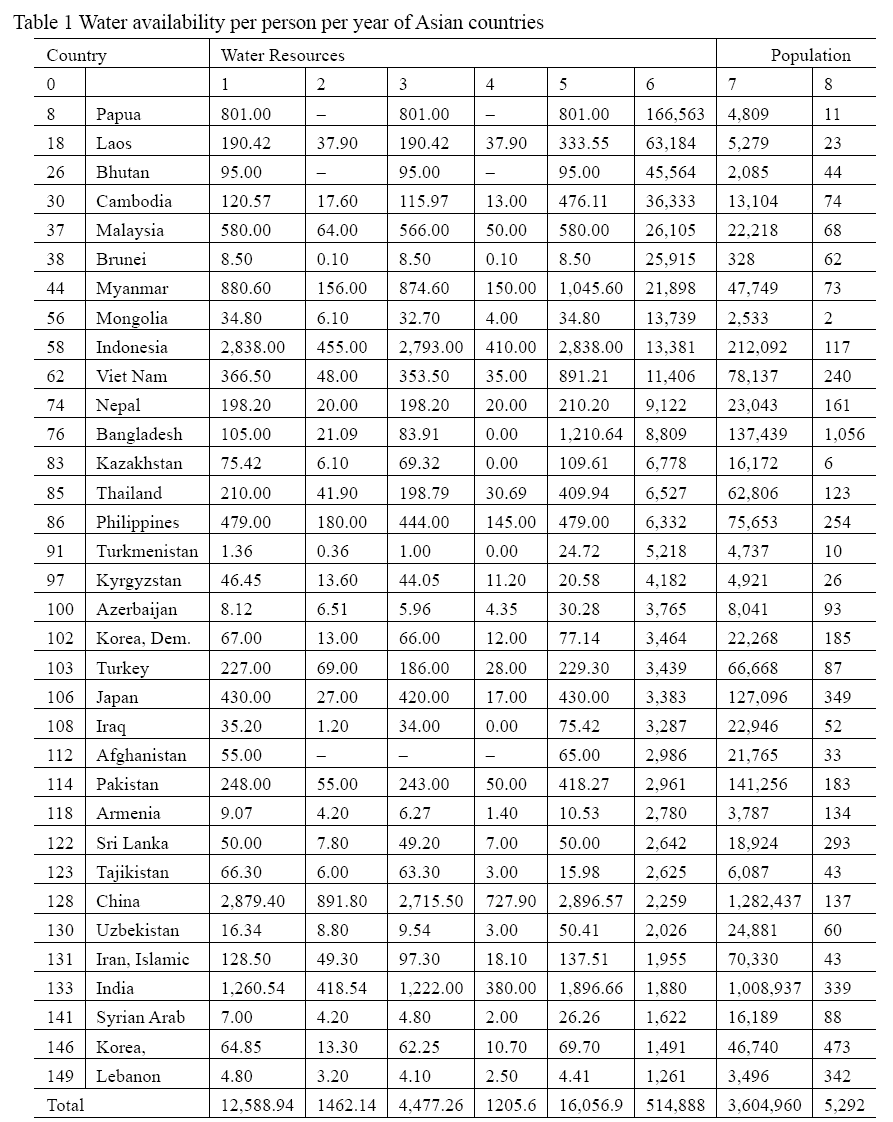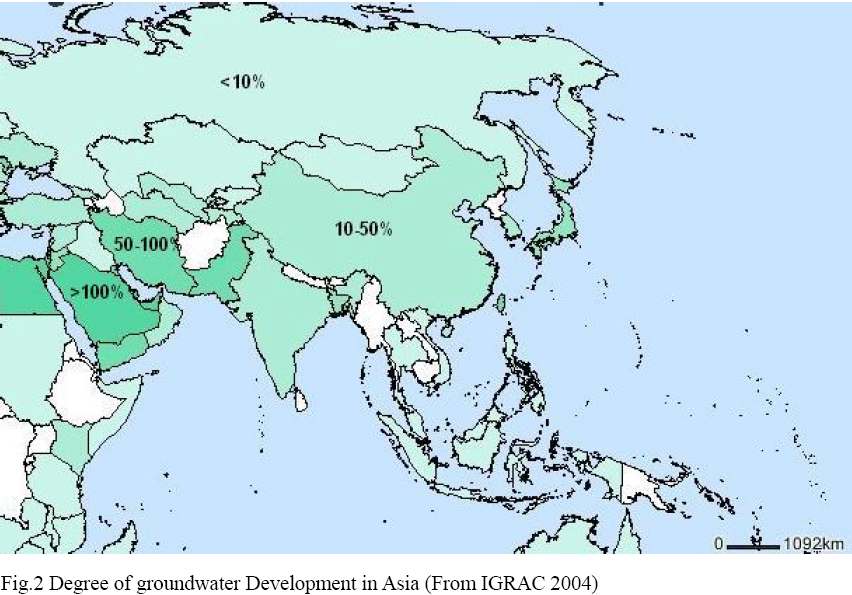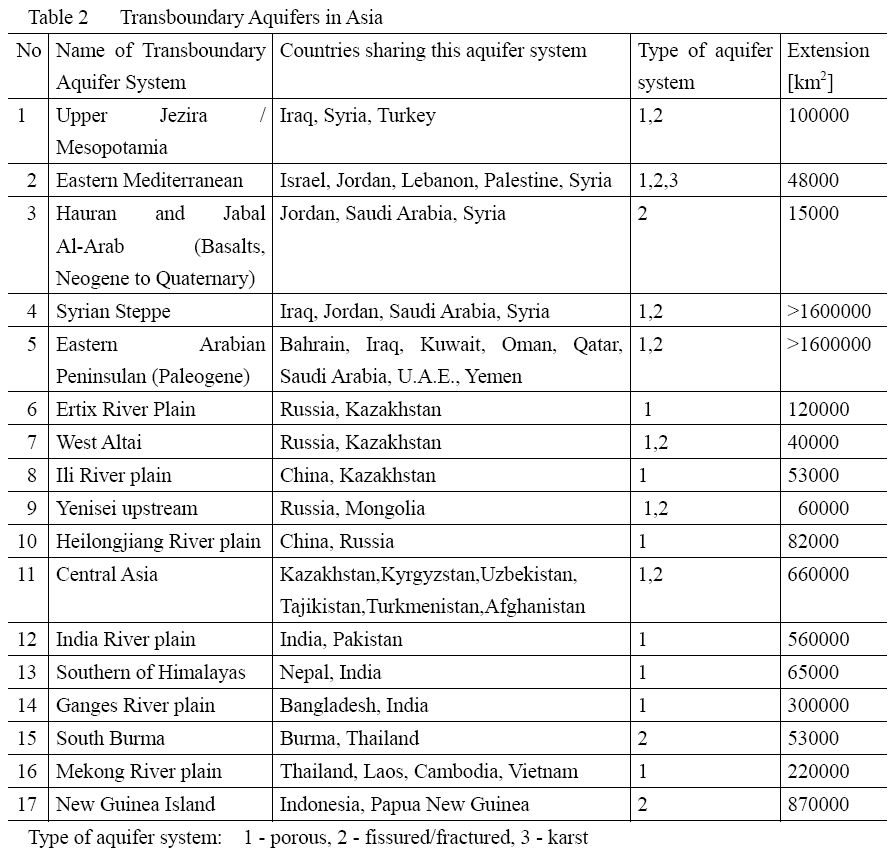Achievements
GROUNDWATER RESOURCES IN ASIA - PROBLEM AND CHALLENGE
Han Zaisheng1,2 Wang Hao2
1China Geological
Abstract: Groundwater resources play an important role in the development in Asia. The hydrogeological conditions are various. Groundwater resources assessments in Asia countries have been taken during last 30 years. The available groundwater resources of Asian countries are presented. The main problems causes by nature issues are the groundwater quality in the arid and semi-arid areas especially in the central part of Asia. Global climate change caused the hydrogological condition diversified in both inland and coastal area of Asia. Problems cause by human action is groundwater overexploitation and related Seawater intrusion to inland, land subsidence and groundwater contaminated occurred in many regions. Transboundary aquifers in Asia are important for building a society where all civilizations coexist harmoniously and accommodate each other. Those problems challenge the hydrogeologists for solution. The main tasks are groundwater assuring for the livelihoods and food security of millions of people, groundwater sustainable usage for the social and economic sustainable development, groundwater monitoring and dynamic assessment for resources management effectively and groundwater dependent ecosystems conservation.
Key words: groundwater resources, Asia, hydrogeological
1 Geography
Asia is located in the east hemisphere. Fig.1 The east,
north, south and west of Asia border on the Pacific Ocean, Arctic Ocean, Indian
Ocean and Mediterranean Sea respectively. The area is 44 million square
kilometer. The population of Asia is 3.5
billion. It is the largest continent both in area and population in the world.
There are 48 countries and regions in Asia. It
could be divided into East Asia, East-south Asia, South Asia, West Asia,
Central Asia and North Asia in geography. The
countries with population more than 100 million are
The plains are situated in the outboard of
mountains and tableland. These are North China plain, Northeast China plain,
Middle and lower reaches of Yangtze River plain, Hindustan river plain, Ganges
river plain, Mesopotamia plain and west Siberian Plain, etc. The Dead Sea is the lowest depression in the world with
altitude 400 m under
sea level. There are many rivers in Asia. Most
of those are source from central mountains and radial flow to every direction.
The major rivers flows into Pacific Ocean are Heilongjiang-Amur
River, Yellow River, Yangtze River,
Pearl River and

Fig. 1 Satellite Image of Asia
2 Characters of Aquifers and Groundwater Resources
Groundwater resources in Asia
are various. Some regions are underlined by aquifers extending over large
areas, while the floodplain alluvial deposits usually accompanying the largest
rivers. The sedimentary rocks, especially Quaternary loose sediments are very
thick with good storage space. The deep fissure water is relatively abundant in
confined aquifers. In mountainous regions, groundwater generally occurs in
complexes of jointed hard rocks. There is a little rainfall and strong
evaporation in inland arid area of central Asia.
However the thawing of glaciers and snow from high mountains is favorable to
recharge groundwater. The loess plateau in the central Asia
has specific topography. Continuously aquifers are only distributed in loss
tableland. The carbonate rocks are widely distributed in Southeast
Asia. In south
Evaluation and mapping of Groundwater recharge and runoff of individual basins and regions are in progress. The hydrogeological survey on a medium scale has performed regional quantitative assessment of natural groundwater resources in most countries of Asia. Groundwater runoff is an important component of the hydrological cycle. Local hydrogeological conditions of difference regions are effect on the distribution of groundwater runoff/precipitation ratios. Those ratios are less than 10% in the arid area in central Asia, and more than 40% in the karstic area in Southeast Asia. Groundwater monitoring networks have operated at national, regional and local levels in some part of Asia.
Groundwater levels constitute the most observed
parameter, continuous water quality and natural groundwater discharge and
abstraction networks are operational in urban area. However groundwater
assessment, monitoring, and data management activities are operated regular in
UNESCO has presented an overview of the available water resources and population of Asian countries as Table 1. The total Groundwater recharge in Asia internally is 1462 km3/year.
The development of groundwater has been increased
in last 30 years. The degree of groundwater development is shown in Fig.2. The
ratio of groundwater abstraction with mean recharge is upon the country. There
are more areas where groundwater is over-abstraction upon the province in a
country. In some arid region of Asian countries, where sufficient renewable
groundwater resources are not available, non-renewable groundwater is being
exploited to support development, such as
Groundwater is crucial for human drinking and food
security, especially in the developing countries. The impact of groundwater use
is positive and included such benefits as increased productivity, food
security, job creation, and livelihood diversification and general economic and
social improvement. In the long run, the impact of groundwater extraction might
be negative especially in over-exploitation situation, such as permanent lowing
of the water table, deterioration of water quality, saline intrusion in coastal
area, etc. The social and economic dimensions of groundwater use are its
benefits are important for the development in Asia.
Some of these benefits are linked to the inherent character of groundwater as
resources, such as most aquifers provide large natural storage space and help
stabilize water supply during peak drought seasons. The sluggish flow of
groundwater through small void helps in purifying water to use as drinking
water. Almost ubiquitous availability of groundwater makes it resources easy to
access. In areas with extensive aquifers endowed with good permeability and
storage properties, groundwater exploitation could increase recharge and also
decrease flood intensity. Groundwater irrigation has also ensured security and
helps alleviate poverty. For example, in
Since the 1970s, groundwater extraction has
increased greatly in

Sources: UNESCO: Water for People Water for Life0 Ranking in the world
1 Total internal renewable water Resources (km3/year)
2 Groundwater produced internally (km3/year)
3 Surface water produced internally (km3/year)
4 Overlap: Surface and groundwater renewable (km3/year)
5 Water resources: total renewable (km3/year)
6 Water resources: total renewable per capita (m3/capita year)
7 Populations in 2000 (1000 Inh)
8 Population densities in 2000 (inh//km2)
2+3-4* Aggregation of data can only be done for internal renewable water resources and not the total renewable water resources, as that would result in double counting of shared water resources.
(-) No data available

3 Problems of Groundwater
in Asia
Problems of groundwater could cause by nature issues or human action. The main problems causes by nature issues are the groundwater quality in the arid and semi-arid areas especially in the central part of Asia. Global climate change caused the hydrogological condition diversified in both inland and coastal area of Asia. Problems cause by human action is groundwater overexploitation and related Seawater intrusion to inland, land subsidence and groundwater contaminated occurred in many regions. Those problems have increased rapidly during last 30 year.
3.1 Groundwater quality
Most renewable groundwater is of high quality for
domestic use and does not require treatment. But there are the resort
groundwater is naturally unacceptable for drinking lead serious problems. In
the arid and semi-arid areas, the salt content in shallow groundwater is high.
High content of arsenic and fluorine of groundwater are in many region of Asia. In
west Bengal, the high level of arsenic in the groundwater used
for drinking water is a public health time bomb. Groundwater sources of 61 out
of

3.2 Overexploitation of groundwater
Groundwater
overexploitation occurred in many areas of Asia, such as Gujarat,
3.3 Groundwater pollution and contamination
Groundwater contaminated is as
a result of industry and subsistence pollution. Those are as a result of
increased economic activities. Drainage waters from irrigated lands, for
example, usually contain high concentrations of objectionable minerals. These
contaminated waters, which flow off the land through ditches, may seep into the
soil and pollute the ground water that is pumped from wells. Countries facing
this kind of problem include the Republic
of Korea,
3.4. Problems related to coastal areas
Seawater intrusion
to inland, encroachment of salt water is also a serious ground-water problem,
particularly in coastal areas. Since a large portion of the region's population
is located along the coasts of oceans and salty seas, there are many problems
of this kind in the region. Some of the countries which have problems of this
nature include Fiji,Guam, Japan,
Thailand and Viet Nam. Basically, encroachment occurs when the water levels in
a fresh-water aquifer are lowered to a point where salt water can invade beds
bearing fresh water. Although the encroachment tends to be a slow process, in
an area where pumping is continuous, encroachment tends to be an irreversible
process. As ground water is extracted from the wells, the salt water slowly
moves through the water- bearing beds in the direction of the wells and, unless
corrective measures are taken, the salt water will ultimately begin to
contaminate the water in the wells. Such contamination manifests itself in a
gradual increase in the salt content of the water being pumped. For example, in
3.5 Land subsidence
In some countries of the region, the withdrawal of large amounts of ground
water has caused serious problems of the subsidence of the land surface. Some
of the counties facing such problems include
4 Transboundary Aquifers in Asia
Transboundary
aquifers, as part of groundwater resource
systems, are important for related Asian countries. They are dealing with the
relationship between the countries or regions, as the international rivers.
There are several transboundary aquifers, which concern two or more countries
in Asia. There are concomitances with rivers
pass through several countries, such as Mekong
River, Ganges
Rivers and
Transboundary
aquifers in Asia have been summarized. They
are basis on groundwater systems analysis. For the
countries such as

Research on transboundary aquifers is significant for the management of shared groundwater resources of neighboring countries or regions.
5 Challenges for Hydrogeologists
Groundwater demands and Dependent Ecosystems problems are driving force for Asian hydrogeologists. There are so many issues for solution. The main tasks are groundwater assuring for the livelihoods and food security of millions of people, groundwater sustainable usage for the socio - economic sustainable development, groundwater management effectively. The groundwater monitoring, dynamic assessment and groundwater dependent ecosystems conservation are the majors. Greater knowledge and improving basic data through research are prerequisites for better management of groundwater system. We should realize just using last century's schemes no longer solves challenges that today's groundwater related. For understanding the characteristics and behaviour of groundwater resources is the basis. The characteristics and behaviour of resources user communities and the institutional framework under which the resource is appropriated and use are also important for us. There is an urgent need for expansion in the knowledge of user and institutional perspectives in the groundwater knowledge base.
In general, there are two basic approaches to dealing with the problems related to over-exploitation of aquifers: the preventive approach and the remedial approach. The main objective of the preventive approach is to forestall over-exploitation by enacting and enforcing appropriate ground-water legislation. The remedial approach is useful for cases where the problem of over-exploitation has already taken place and usually requires recharge of the aquifers by artificial means. It should be noted that artificial recharge of aquifers is not always possible, and even if it is, it tends to be a costly process. Another possible measure to solve over-exploitation of ground water is to limit or reduce the supply of ground water and increase that of surface water. In this regard it is necessary to have integrated management of both surface and groundwater resources.
Groundwater benefits thereof deeply impacetd Asia. Groundwater use has indeed involved drinking, food production and created livelihood opportunity for million people. The prime aim in governing groundwater is to ensure the negative is to devise ways and means of reducing the negative impact of groundwater usage without signigicantly reducing benefit flows. In this context, hydrogeologists in Asia have an important role to play providing timely data and analyses that will help to decision makers in formulating implementable and socially acceptable policy respinses.
Reference
[1]
Institute of hydrogeology and Engineering Geology, Chinese
Academy of Geological Sciences, 1996, Hydrogeological
Map of Asia 1:8 M,
Geological Publishing House,
[2]
UNESCO, 2003, World water Development Report: Water for People, Water for
life, UNESCO and Berghahn Book,
[3] Igor S. Zektser, Lorne G. Everett, 2004, Groundwater Resources of the World and their Use, UNESCO IHP-VI, Series on Groundwater No.6
[4] Alaerts, G.J. and Khouri N., 2004, Arsenic, contamination of groundwater: Mitigation strategies and policies. Hydrogeology Journal 12, 103-114.
[5] Aditi Mukherji & Tushaar Shah, 2005, Groundwater Socio-ecology and Governance: A review of institutions and policies in selected countries, Hydrogeology Journal (2005) 13:328-345
[6] United Nations, 2006, Water: A Shared Responsibility, the United Nations World Water Development, Report 2, 2006.3, http://www.unesco.org/publishing




